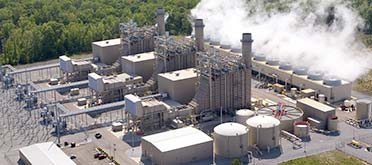Caledonia Combined Cycle Plant

Efficient power production to help meet TVA’s intermediate power needs.
TVA leases the Caledonia Combined Cycle Plant near Columbus, Miss. This 120-acre facility in Steens, Miss., near Columbus reduces the need for TVA to purchase higher-priced power from external sources during periods of high demand. It is one of 12 combustion-turbine sites in the TVA power system and one of four TVA sites with combined-cycle units.
The plant's three units run on natural gas and can reach full power in as little as two hours. They are capable of cycling on and off daily and are used 12 to 16 hours per day to meet power demands longer than peaks but briefer than continuous base-load.
The site is interconnected with the TVA transmission system and neighboring systems. The plant's make-up water requirements are provided by waste water from the City of Columbus via a 16-mile pipeline.
How it works
Combined-cycle units are enhanced versions of single-cycle combustion turbines. They burn natural gas or low-sulfur oil and operate on the same principle as a jet engine. Air entering each unit is compressed, mixed with fuel, and ignited. The hot gas expands through turbine blades that turn generators to produce electricity.
Combined-cycle units generate 50 percent more power than simple-cycle turbines from the same amount of fuel. They do this with a heat recovery steam generator, which uses the exhaust from the first turbine to produce steam that can generate additional electricity from a second turbine.
The Caledonia plant can produce extra steam and 75 megawatts more power by operating additional burners in the second combustion phase
-
a process called duct firing.
Emissions
Caledonia's selective catalytic reduction system reduces nitrogen oxide emissions to about 30 percent of that emitted by a simple-cycle combustion turbine using similar technology.